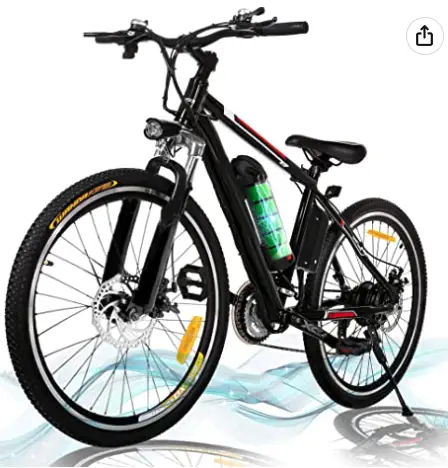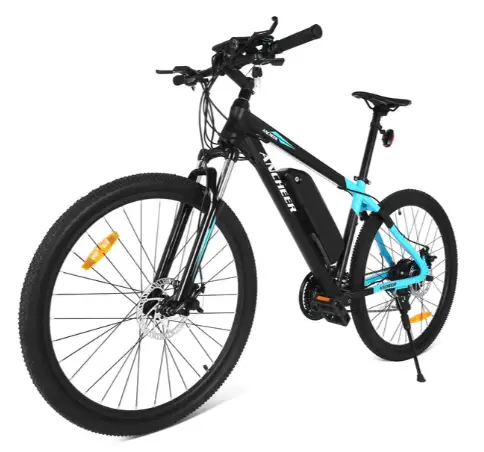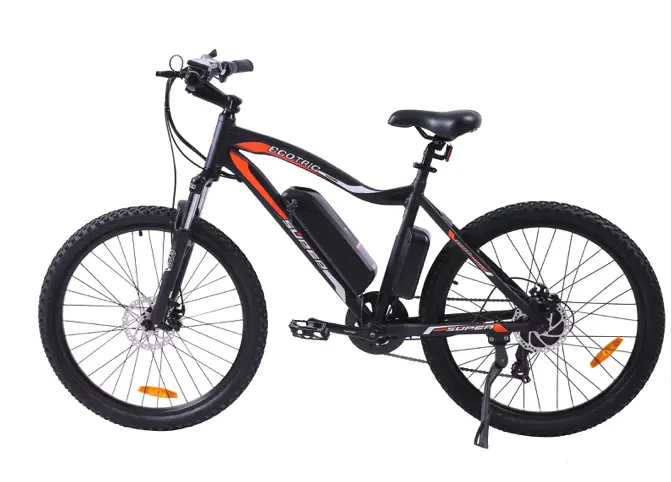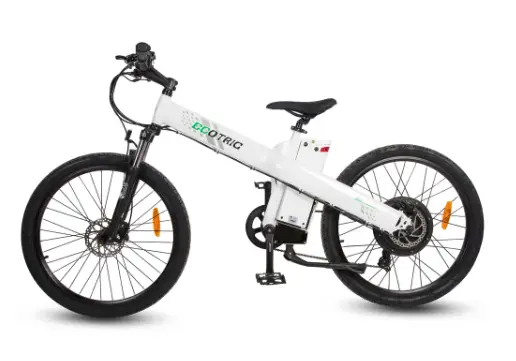On an e-bike, a rider pedals just as on a regular mountain bike, but the motor propels the rider, assisting them in powering the bicycle. Electric bikes make navigating trail systems and rough terrain more manageable. But are they good for mountain biking?
The pros of an e-bike for mountain biking include durability, reduced effort, the ability to travel further on rough terrain, easier rides, and a wide range of models. Cons include safety concerns, shorter range, weight, battery life, specialized parts, and a learning curve.
This article examines the pros and cons of using an e-bike for mountain biking. Read on to find tips for improving your mountain biking experience with an electric bicycle.
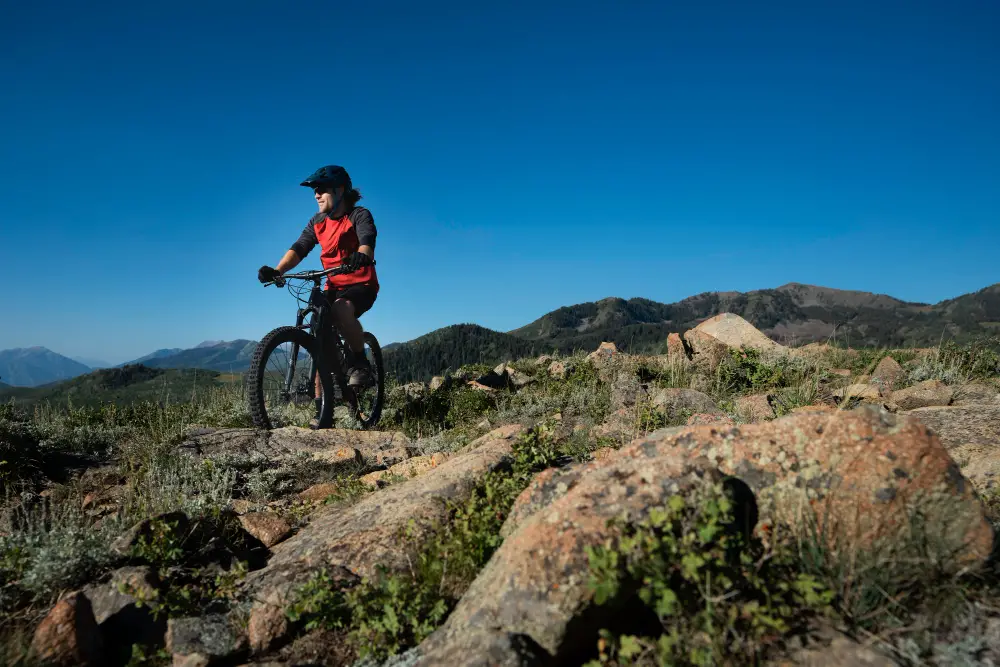
The Pros of Using an E-Bike for Mountain Biking
Electric bikes are no longer an obscure niche product. From 2019 to 2020, e-bikes sales rose by 145%, while in 2022, fuel prices helped spike e-bike sales even further. It’s safe to say that many people find these bikes beneficial. In this section, we’ll look at several reasons why using an e-bike for mountain biking can make the experience more enjoyable.
Electric Bikes Are Durable
Because they require more internal components, electric bicycles weigh more than traditional mountain bikes. Most e-mountain bikes (e MTB) feature a strong frame, thick, tough tires, and a large chassis. Not only do these parts increase durability, but they also allow the e-bike to carry more weight.
With an electric bike, you can bring along all of your hiking gear without fear of the bike collapsing under the weight of you and your equipment.
You Won’t Sweat as Much on the Trail
Many trail bike riders invest in moisture-wicking garments (Amazon) to prevent uncomfortable sweat build-up while hitting the trails. For others, they’d rather avoid profuse sweating entirely. Fortunately, with e-mountain bikes, you won’t sweat as much when you’re navigating the rugged terrain.
When riding an electric mountain bike, your heart rate stays lower (around ten beats per minute lower) than if you were on a regular bike — but you’ll still be getting an adequate workout.
The reason e-bikes require less effort to ride is their pedal assist motor. It allows you to do less work when climbing steep hills or riding along particularly bumpy ground. Some electric bikes even allow you to forego pedaling altogether (with the help of a throttle)!
E-Mountain Bikes Allow You To Travel Further
Non-electric mountain bikes require more effort to cover a certain range than electric mountain bikes. For example, the effort needed to travel ten miles on a conventional bike is closer to twenty miles on an electric bicycle.
Over the past several years, the range of electric bikes significantly increased thanks to better battery technology. With a minimum range of around 20 to 30 miles (32 to 56 kilometers) and top ranges reaching over 45 miles (72 km), a rider can cover more ground on an electric mountain bike in a shorter time—even without using electric assistance throughout the entire ride.
You Can Tackle More Obstacles
Not only can you cover more ground on e-mountain bikes because of the range and power, but you can also explore more areas, including those that you cannot access on a conventional mountain bike.
You can explore more deeply, and when you ride along rugged terrain, the electric bicycle designed for mountain trails delivers more torque, has a solid down tube, and has better suspension performance, allowing for a smoother ride and better experience overall. No longer do riders have to worry about riding uphill—with an e-mountain bike, you can zoom right up, push through headwinds with little effort, and ride over other obstacles with ease.
What’s even better is that you won’t end up feeling as worn out as you would if you were riding a standard bike, depending on your riding style of course.
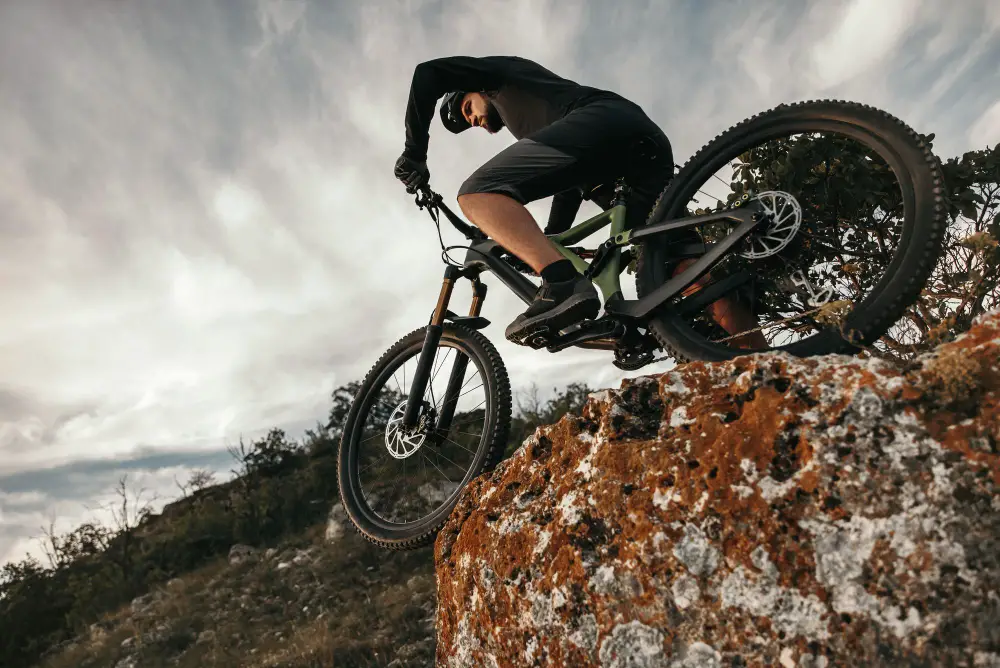
Electric Bikes Are Great for Those With Mobility Issues
Those who experience certain disabilities or mobility issues may have newfound freedom after investing in an e-bike. Electric bicycles may allow a former bike rider to ride again, even if they’re a senior rider with mobility issues.
For example, an elderly woman who once enjoyed mountain biking can no longer pedal up large hills but does just fine on flat trails. An electric bike could assist her through the areas that she otherwise couldn’t pass, and she could pedal regularly on flat surfaces.
In addition, e-bikes make it easier for people of different fitness levels to ride together. It reduces the likelihood that a rider has to speed up or slow down to stay with their friends. With an electric bike, friends and families with children can ride together without the inconvenience of starting and stopping.
There’s a Wide Selection of E-Bike Brands, Types, and Models
A decade ago, the selection of electric bicycles was very limited. As popularity increased, so did the range of types and models available in the bike industry. Today, the selection of e-bikes is practically the same as the range of conventional bicycles. There are many categories, including the best electric mountain bikes (also known as E-MTBs) and fat tire bikes that can be ridden on mountainous terrain.
Because of their ever-growing popularity, there’s a good chance that your favorite bicycle brand offers the best electric mountain bike for you. Just head on over to their website to check for yourself!
The Cons of Using an E-Bike for Mountain Biking
Despite the many benefits of electric bikes for mountain biking, they’re not for everyone. There are cons to consider before diving right into using an e-bike on trails.
Electric Bikes Have Some Safety Concerns
Riding an electric bike is similar to riding a regular bike, but the speeds can be higher. Although not drastically higher, the difference is quite noticeable once you’re actually riding.
As such, the risk of serious injury goes up. Always wear a helmet and safety gear — no exceptions. Even those used to riding an e-bike may accidentally hit the throttle when getting on or off their bike—and this can cause severe injury or even death if the rider falls and hits their head.
It’s important that all electric bike owners familiarize themselves with their bicycles. It’s best to practice riding your e-bike in a soft, open area, such as a field or grassy patch. With time, you should become more comfortable and used to the features and how fast you can go.
Finally, while uncommon, there is the possibility that the lithium-ion battery in an electric bicycle could catch on fire. There were 75 e-bike fires in New York City in 2021, causing 72 injuries and three deaths.
Electric bike owners may reduce this risk by taking the following precautions:
- Never purchase aftermarket batteries — only buy from qualified laboratories.
- Follow all manufacturer instructions when charging or storing your e-bike battery.
- Do not use aftermarket chargers or cords.
- Keep batteries away from direct sunlight and flammable materials.
- Dispose of batteries that change shape, smell odd, or leak.
- Never leave the e-bike or batteries charging while unattended.
- Dispose of a lithium-ion battery at a proper facility.
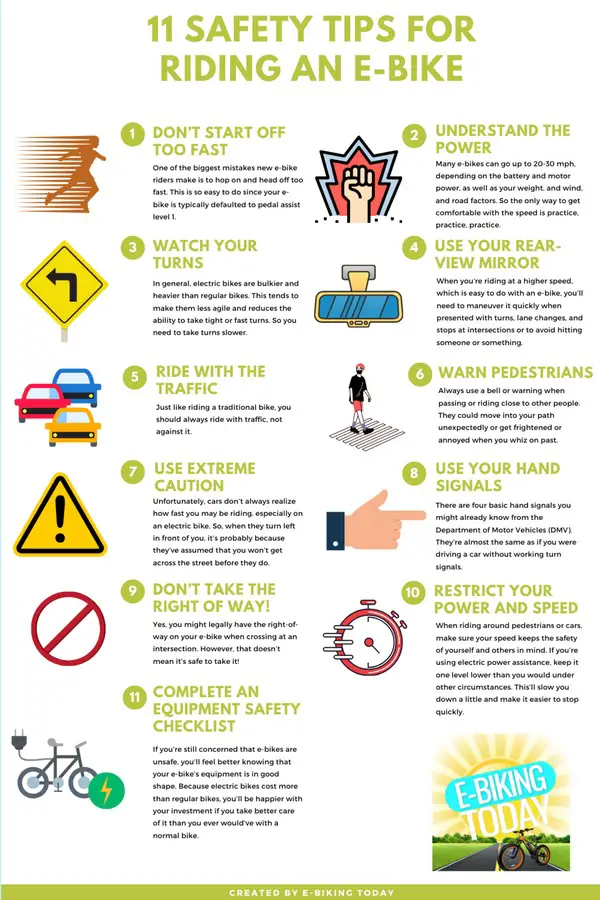
E-Bikes Have a Shorter Range
While riders can typically cover more ground on an electric mountain bike versus a conventional mountain bike, the range still remains shorter than a standard bike once you consider battery life.
The battery lasts, on average, around 3 to 5 hours—but the rugged terrain and high speeds drain batteries even quicker.
In short, an electric bicycle might not provide enough battery life to sustain a full day’s ride. It’s not a wise investment for those who prefer spending a full day riding in the mountains or along backwoods trails unless you carry a second battery.
With that said, you can still ride an e-bike once the battery dies. However, since it’s heavier, it will be more difficult, especially on rough terrain. Always check out your battery capacity before you reach the trail access!
Electric Bikes Are Heavier Than Standard Mountain Bikes
E-bikes have more components and a sturdier build than conventional mountain bikes, which makes them heavier. However, there are lighter electric bike options (usually made with aluminum frames).
Weight isn’t much of a concern for most mountain bikers, but it can cause issues when traveling with the bike or if the battery dies on a particularly difficult uphill climb. And, when you add in rider weight, you’ll most likely prefer consistent power delivery.
To avoid getting into this situation, always pay attention to battery life when riding.
E-Bike Batteries Can Be a Hassle
When you’re traversing along in the woods or on a mountain trail, it’s highly unlikely that you’ll have access to a charging station—so if the battery dies, you’re out of luck.
Fortunately, there’s a way to extend battery life by alternating between modes. Some electric bikes offer full-throttle, pedal-assist, and pedal only.
When riding uphill, you could use full throttle, but on flat surfaces, you could switch to pedal-only mode. Pedal assist is best reserved for smaller hills or rugged terrain that’s otherwise easily passable. This mode basically allows you to use less force when pedaling.
Some e-bike models offer swappable batteries, which means you can always have a backup ready to go. However, electric bicycle batteries take a long time to charge—anywhere from three to six hours. While there are quick-charging bicycle chargers available, they use higher amps, and higher amps are hard on the battery.
E-Bikes Require More Specialized Parts
When you look at an e-mountain bike and a standard bike, they look about the same—and the majority of the parts are the same. It’s the extra parts that make electric bikes more expensive.
These complex, specialized parts are unique to motorized bikes. They’re harder to find, making them more difficult and expensive to repair when the need arises.
Not only that, but most electric bike owners use their e-bikes more often, riding for longer distances at higher speeds. This increases the mileage on the bike, which, in turn, wears down the parts. When parts wear down, you have to perform maintenance more often.
The most common components that need to be regularly replaced include tires, chains, and brake pads. It sounds simple enough, but the chains are thicker and stronger to account for the torque of the electric motor. Tires, too, are specialized. They are thicker and provide more traction than standard tires, and they must be rated for higher speeds.
All of these components can quickly increase the cost of ownership.
Slight Learning Curve
The phrase, “It’s like riding a bike,” means that once you learn how to do something, it’s difficult to forget. However, when it comes to e-bikes, there is a slight learning curve.
It’s easy to hop on and ride without issues when treating it as a standard bike and using the pedal-only mode, but when it comes to the speed capabilities, things can get startling. When using pedal-assist, there’s a “kick” that can catch you off guard if you don’t expect it. Also, the added weight due to the extra components may require riders to readjust themselves for balance.
Also, there are more controls on an e-mountain bike versus a standard mountain bike. Riders must learn to use the throttle and be mindful during shifting to avoid damaging the chain and gears.
How To Improve Mountain Biking With an E-Bike
As you can see, there are many pros and cons to using e-bikes for mountain biking. If you’re still interested in obtaining an electric bicycle for your mountain biking adventures, here are some tips for improving the experience.
Choose an E-MTB
There is a multitude of electric bikes on the market, but the best electric mountain bikes for mountain biking are E-MTBs.
E-MTBs differ from standard e-bikes in that they have flat handlebars, tires with better traction, and a better suspension system for rugged terrain. They’re safe and comfortable for rides on roads, gravel, and mountain trails and come in hardtail or full suspension.
These specialized e-bikes provide better climbing power, delivering torque faster and more efficiently when spinning the crank arms at a higher cadence. Not only does a higher cadence make the motor power more efficient, but it also extends the battery life.
Because electric mountain bicycles are heavier, the tires form better to the ground, allowing the rider to roll over bumps, nooks, and roots that they otherwise would have bounced over on a standard bike. Not to mention, the extra traction makes skidding less likely.
While an electric mountain bike is a great tool for any backpacker, it’s important to remain aware when you’re out on the trails. A higher cadence means more downstrokes, which could put you in a potentially hazardous situation. Coast with both pedals at the same height to avoid catching rocks or roots.
Save Battery Power
When riding an electric mountain bike, be mindful of the mode you’re riding in. Don’t make the bike do all of the work, all the time. Select the level of assistance that’s adequate for the terrain in order to increase the battery range on the e-bike.
Also, avoid stopping and starting again and again. This quickly reduces battery life, as it requires a lot of juice to regain speed from a stopped position.
When riding bikes downhill, turn the motor system off. Also, if your e-bike came equipped with the regenerative braking feature, utilize it here to give your battery a little extra juice.
Always Ride Safely
Safety is essential when riding an electric bicycle. When you know that you’re riding safely, you’ll feel more confident, meaning you’ll be more able to enjoy the experience as you traverse along mountain paths.
Before heading out on your mountain bike adventure, ensure that the suspension on the electric bike is adjusted to your weight, plus the weight of your gear and equipment (including knee and elbow pads, helmet, and backpack).
Check the tires to ensure they’re running on the proper PSI (check the manufacturer’s website to find the recommended air pressure).
Opt for Flat Pedals
If you’re new to riding e-bikes in the mountains, it’s best to start with flat pedals. Not only does this increase the safety of your electric bike, but it also provides a much smoother ride when you’re working on your riding technique.
When feeling unbalanced, it’s easy to quickly pull the feet away from flat pedals, but clipless pedals increase the likelihood of becoming stuck.
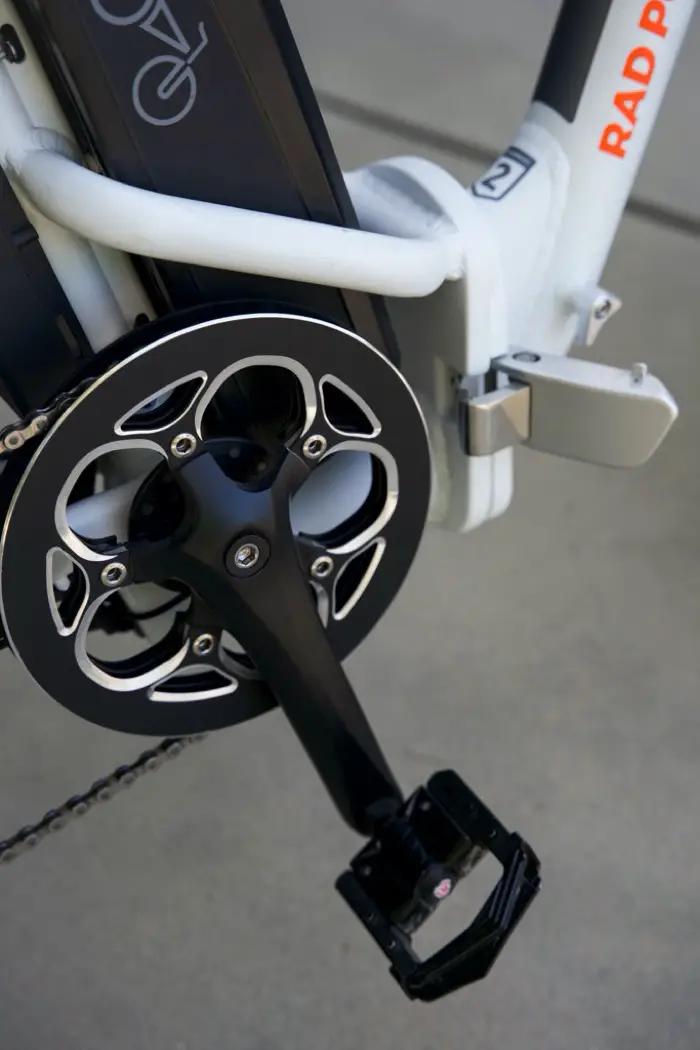
Learn How To Navigate Tricky Situations
Climbing and riding along downhill curves on an electric bicycle is a little different than doing so with a traditional bike. Knowing how to navigate these situations increases rider confidence and makes the mountain biking experience more exciting.
Here, I’ll give you a step-by-step on how to navigate three different situations riders may encounter while mountain biking on an e-bike.
Climbing Hills
- Switch to low gear with a consistent cadence (about 80-90 RPM).
- Sit in the saddle for better rear-wheel traction.
- Lean forward on particularly steep sections to shift your weight.
- Bring your shoulders in towards the handlebars, with elbows at the sides.
- Pull the handlebars back and down to prevent the front wheel from rising.
Braking
- Always check the brakes before heading to the trails.
- Shift the center of gravity higher when braking.
- Stay strong during braking; “cowering” down may cause you to slide.
Taking a Downhill Curve
- Pull yourself down — head and shoulders — keeping the center of gravity over the center of the bicycle.
- Push the bike into the curve.
- Look beyond the curve as you enter it.
- Apply the rear brakes right before the turn.
- Accelerate very slowly in the curve to generate more traction.
Final Thoughts
Overall, the advantages of e-bikes for mountain biking outweigh the disadvantages. It doesn’t matter whether you’re a novice or experienced rider, it’s hard to beat the experience of an electric bicycle on a rugged mountain trail. I hope this article helped you dive into the world of electric bikes and mountain biking.

